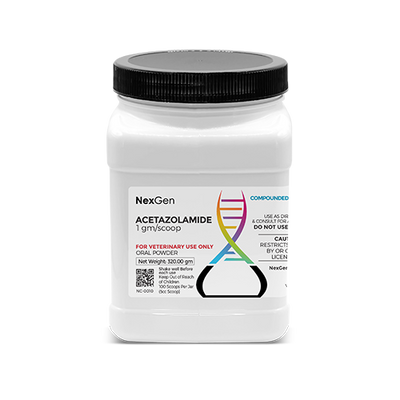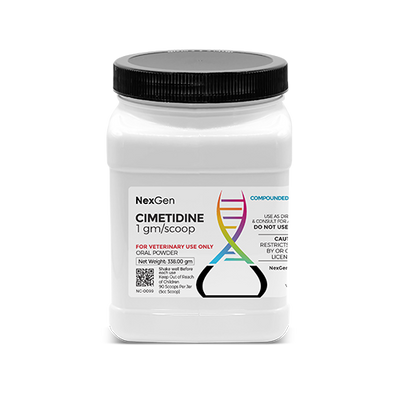
Omeprazole 1 gm/scoop + Sucralfate 3 gm/scoop, Oral Powder, 120 Scoops (5cc Scoop)
Login for pricing
- Brand
- Mixlab
- SKU:
- NC-0124
- Product Type:
- Powder
- Size:
- 32oz
- Administration:
- Oral
- Scoops Per Container:
- 120
- Scoop Size:
- 5cc
Gastric ulcers (Equine Gastric Ulcer Syndrome, or EGUS) in horses are caused by prolonged exposure of the gastric mucosa to gastric acids. This results in ulceration and bleeding in some instances. The horse’s stomach can be described as having two sections: An upper non-glandular region where food enters the stomach, and a lower glandular region where hydrochloric acid (HCl) is produced. While the lower region is constantly exposed to gastric acids, it generally has adequate protection from these acids; thus, lesions are most commonly found in the upper region.
EGUS is most closely associated with performance horses, horses that have been stressed over a protracted period of time, and horses that were sick to start with. Its prevalence in unmedicated racehorses in active training is at least 90%, whereas in non-racing performance disciplines, its prevalence is over 60%.1 Foals are known to be at high risk for development of perforating peptic ulcers until they are several weeks old due to the undeveloped state of their gastric mucosa. While spontaneous remissions of these lesions have been described in the literature, horses that remain in situations tending to give rise to this malady are likely to remain ill without medical intervention.
Horse’s stomachs are smaller in comparison to other species of similar size; in the wild, they are a grazing animal that eats periodically throughout the day. Consequently, the feeding regimens demanded by owners, managers and trainers tend to run counter to the horse’s natural biological processes. “In a natural grazing situation, a steady flow of acid is required for digestion, so a horse’s stomach produces acid 24 hours a day, 7 days a week – up to 9 gallons of acidic fluid per day, even when not eating. In a natural, high-roughage diet, the acid is buffered by both feed and saliva. When horses are fed two times per day, which is common in many boarding situations, the stomach is subjected to a prolonged period without feed to neutralize the acid. In addition, high-grain diets produce volatile fatty acids that can also contribute to the development of ulcers.”2
Stress is also believed to be a major contributor to EGUS. Transportation, stall confinement and the rigors of performance (where performance horses are involved) are all additional risk factors for EGUS. Finally, the repeated administration of nonsteroidal anti-inflammatory drugs (NSAIDs) can impede the production of mucus in the stomach, making the horse far more susceptible to ulcers.
Gastric Ulcers in the Horse: Clinical Signs
Most horses suffering from EGUS do not exhibit overt clinical signs; in fact, these horses almost always appear completely healthy. Some of the more subtle signs of EGUS can include:
- Poor appetite
- Weight loss
- Dullness
- Changes in mood and/or behavior
- Decreased performance
- Reluctance to train
- Poor body condition
- Dull coat
- Colic
Horses with more serious cases of EGUS may experience abdominal pain and/or display grinding of the teeth.1,2 Occasionally, a horse with advanced ulcerative disease may be found on its back. This is more common with foals, and it is believed that this position provides relief from the pain associated with acidic fluids bathing sensitive parts of the stomach. Some horses will walk away from food if they experience discomfort with the first mouthful.1
In foals, the clinical signs of ulcerative disease include intermittent colic, frequent recumbency, reduced nursing, diarrhea, poor appetite, a pot-bellied appearance, grinding of teeth, and excess salivation.1 If a foal exhibits clinical signs, the ulcers are likely to be severe and should be diagnosed and treated immediately.
Equine Gastric Ulcers: Diagnosis and Treatment
Gastric ulcers can only be diagnosed definitively through endoscopy. This involves inserting the endoscope into the stomach and performing a visual examination of the stomach mucosa. The procedure is minimally invasive, produces minimal stress in the horse and allows for examination of the esophagus, stomach, and small intestine.2 The veterinarian can generally make a tentative diagnosis based on visible clinical signs.
Omeprazole is sold as a paste or powder formulation and has been very effective in preventing and treating gastric ulceration in all types of horses. Since the commercial paste is on the expensive side, some compounding pharmacies prepare and sell paste or liquid omeprazole at lower prices.3 Preventative doses of omeprazole are commercially available for use in transportation or stressful events. It is believed that horses with a history of gastric ulceration can benefit from proactive treatment to decrease the chances of ulcer formation or recurrence.
Sucralfate is effective in treating ulcers affecting the glandular part of the stomach. Since ulcers in foals and adult horses often involve the non-glandular part of the stomach, a veterinarian's diagnosis is important.3,5 In cases involving the squamous type of mucosa or stomach/intestinal lining, sucralfate may be used in addition to other drugs, such as omeprazole or rantidine.3 Sucralfate coats ulcers, provides symptomatic relief, and can aid ulcer healing along with omeprazole.
Treatment should be initiated immediately for horses with severe gastric ulceration, horses with clinical signs of gastric ulceration, and horses that are under stressful conditions and at risk of gastric ulceration.
Where to buy Omeprazole + Sucralfate Powder
Omeprazole + Sucralfate Powder is available in the U.S. through veterinary custom compounding companies.
Please consult your veterinarian prior to beginning any treatment regimen.
FOR RX ONLY: A valid prescription from a licensed veterinarian is required for dispensing this medication.
1Merck Veterinary Manual.
2Young, A. Equine Gastric Ulcer Syndrome. In: Journal UC Davis School of Veterinary Medicine, July 29, 2019.
3Andrews, F. Gastric Ulcers in Horses. In: Merck Veterinary Manual, Jan. 2014.
5Loving, N. Research on Treatment of Equine Gastric Ulcer Syndrome. In: EquiManagement.com, Jan 13, 2019.















